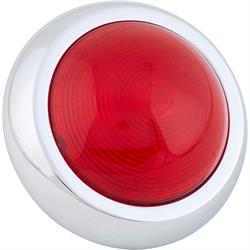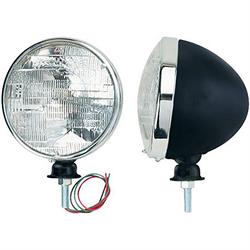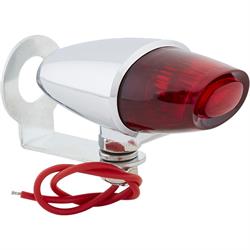Vulcan Redux Part Two
Welcome back to the Vulcan Drifter project! Last time I touched on all the extra “stuff” this bike had hanging off of it. It’s about time we do something about that.
I also mentioned previously that I’m not a big fan of chrome just for chrome’s sake. This attitude rubs a lot of bikers the wrong way. Street rodders too. Trust me. I’m a designer and the picture in my head is awesome. Now, let’s get rid of that awful headlight and menagerie of chrome on the rear fender.
I started where you should always start a project. With the Speedway catalog. I wanted to get rid of the clutter and I wanted to end up with black painted headlight and turn signal buckets. I also wanted to pull the headlight way back toward the triple tree and get the signals tucked inside the width of the forks.
I decided on a Dietz headlight with a painted bucket and chrome trim. For the front turn signals I splurged on a really nice set of stainless ’32 Ford cowl lights. For the rear signals I went with our Pony lights just below the new springer seat mounts. A ’50 Pontiac tail light was a must. It keeps that clean and simple Indian style but with modern LED visibility and a low price to boot. Plus when you’re working on a bike, you get an extra head and tail light too! How can you beat that?
In order to use all of these parts I needed to fabricate some new mounts. No hill for a climber. I started with the new headlight mount. It’s built from part of the original light mount and some 1”x2” channel that I had in the iron rack. Once I settled on the positioning I trimmed, drilled and contoured the shape.
The economy of design is a big part of a cycle build. So my turn signals will also mount from this point as a sandwiched layer. That mount was made from ¼” aluminum bar. Since It would need to be twisted in the center I used a material that was easier to form. This twist is because the ’32 lights are made to be mounted on the tapered cowl. Also worth noting: All the parts attaching here use an indexing pin to keep the alignment true and use just a single center mounting bolt.
The rear fender was quite a bit more straightforward. Much messier, but straightforward. I removed all of the factory stuff and threw it in the scrap heap. Then I fished the back bumper out, cut half of it off and put it in the “save” pile. The fender had a big cavity in it for the factory light assembly. Since the LED lights are flush mount there was no need to keep that. I ground off the box from the back side and ‘glassed the hole shut with regular fiberglass mat and resin. The light required three holes. Two to mount and one for the wires.
Stay tuned for the conclusion of the project in Part 3 – Vulcan Drifter Paint & Reassembly


